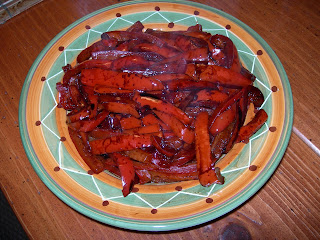Bobotie from South Africa

2 onions, finely chopped
2 pounds ground beef, or a mix of ground meats
1 slice bread
1 cup milk
1 tablespoon curry powder
½ teaspoon turmeric
1½ tablespoons sugar
½ cup raisins
3 tablespoons chutney, chopped
2 teaspoons salt
½ teaspoon pepper
Zest of 1 lemon
2 tablespoons lemon juice
¼ cup slivered almonds
1 egg
1. Pre-heat oven to 350ºF.
2. Sauté beef or meat mix with onions until meat is brown, breaking the meat up into small pieces. If necessary, drain fat from the pan and discard.
3. Soak the bread in half the milk; mash it with a fork. Add it to the meat.
4. Combine all the remaining ingredients except the egg and the remaining milk. Spread the mixture in a greased casserole.
5. Bake for 20-30 minutes. Beat the egg with the remaining ½ cup milk and pour it over the casserole. Return to the oven for another ½ hour.
6 servings
Adapted from The Africa News Cookbook
Braised Carrots

2 tablespoons olive oil
1 pound carrots, peeled and cut into 3½ x ½ x ½-inch sticks)
6 cloves garlic, peeled and sliced
2 medium tomatoes, seeded and chopped
¼ cup chopped fresh mint
3 slices lemon, seeds removed, plus juice from the rest of the lemon
1 tablespoon sugar
1 teaspoon salt
½ teaspoon anise seeds
½ teaspoon ground cumin
Pepper
2 tablespoons chopped fresh parsley
1. Put the oil and the carrots into a heavy 10-inch skillet. Cook on high heat, stirring and shaking the pan often and scraping the browned bits occasionally with a wooden spoon, until the carrots have lightly browned, about 10 minutes.
2. Add the garlic, tomatoes, mint, lemon slices, sugar, salt, anise and cumin; mix well.
3. Cook until bubbling vigorously; reduce heat to low. Cover and cook for 10 minutes. Stir, turning the carrots. Cover and cook until the carrots are very soft, 10 minutes or so more. Add lemon juice and season with pepper. Remove the lemon slices.
4. Before serving, sprinkle with parsley. Serve hot or at room temperature.
If you make this ahead, you can reheat for 1-2 minutes in the microwave.
4 servings
Adapted from Eating Well, February/March 2006
Oven-Roasted Zucchini

8 medium zucchini, thickly sliced (½ inch) on the bias
2 tablespoons olive oil
2 garlic cloves, pressed
or 2 roasted garlic cloves, chopped, and 1 fresh garlic clove, pressed
2 tablespoons chopped fresh flat-leaf parsley
6 fresh basil leaves, chopped or ¼ cup chopped herbs of your choice (tarragon and chervil or tarragon and thyme or oregano and thyme or dill are all good)
Zest of 1 lemon
Juice of ½ lemon
Salt and pepper
1. Place the zucchini in a roasting pan(s), add the olive oil, toss to coat, and arrange in a single layer. Sprinkle lightly with salt. Put the pan(s) in the oven and turn the temperature to 425ºF. Roast for 30-40 minutes, turning once mid-way. The zucchini should be nice and brown on both sides.
2. Mix together the garlic, parsley, lemon zest, and herbs.
3. Make a layer of some of the zucchini slices on a serving dish. Sprinkle with some of the herb mixture, season with salt and pepper and drizzle with the lemon juice. Continue making layers until all the ingredients are used, ending with some herbs on top.
4. Set aside in a cool place for about an hour for the flavors to mingle before serving. Can serve warm or at room temperature. To warm slightly, put the dish in a microwave and heat for 1-2 minutes.
Note: I have made just steps 1 and 2 of this recipe with salt added along with the olive oil. Even at its most simple, it is a delicious dish.
4-5 servings
Adapted from The Silver Spoon, a comprehensive cookbook of Italian food.
Yellow Rice
1½ cups basmati rice
2 tablespoons oil or butter
2 2/3 cups water
½ teaspoon turmeric
¼ cup raisins or currants, optional
1 stick of cinnamon
1½ teaspoons salt
2 tablespoons olive oil
1 onion, peeled and finely chopped or sliced, optional
4 tablespoon desiccated coconut, optional
Salt and pepper to taste
1. Heat oil or butter in a heavy saucepan over medium heat. Add the rice and sauté until the individual grains are shiny, about 1 minute.
2. Add the turmeric, raisins or currants, cinnamon, water and salt and bring to a boil. Cover the pan and turn the heat to low. Cook for about 20 minutes.
3. While the rice is cooking, heat the 2 tablespoons oil over moderate heat in a frying pan and sauté the onions until they are golden.
4. Once the rice is cooked, fluff it with a fork, and stir in the onions and coconut or spread them over the top, if desired. Add salt and pepper if needed.
Serves 5-6
Adapted from Lehla Eldridge’s The South African Illustrated Cookbook













